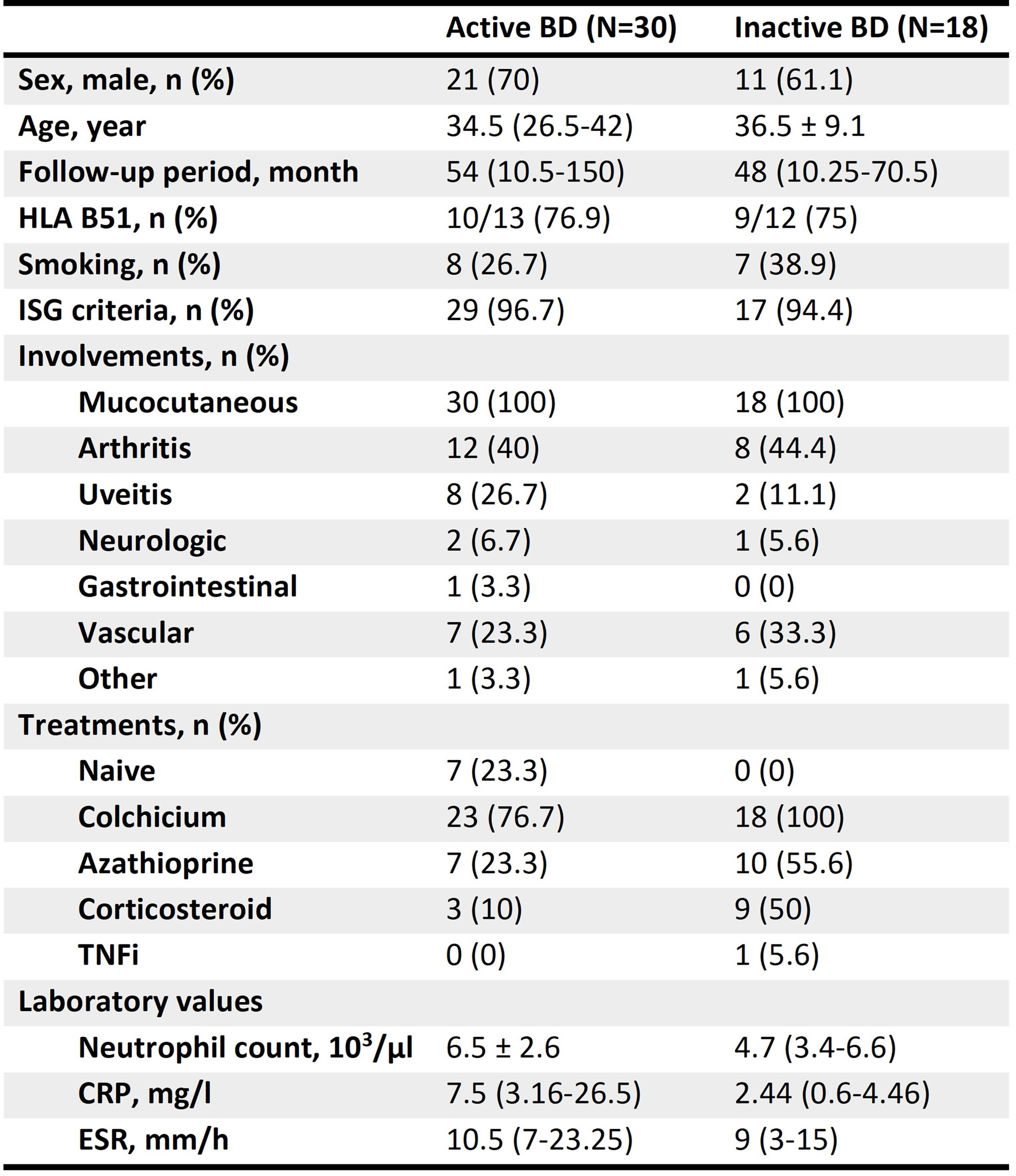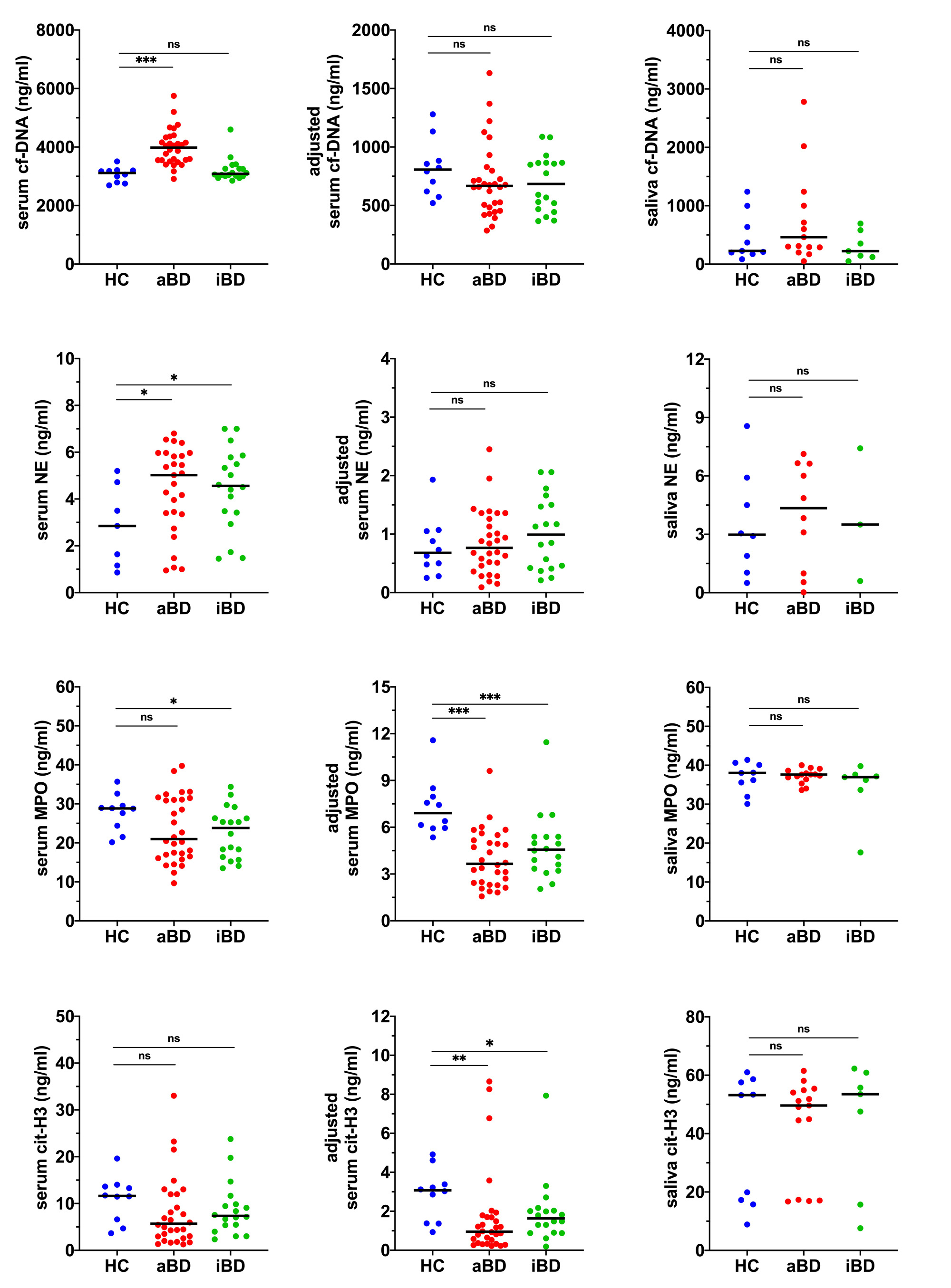Session Information
Date: Tuesday, November 14, 2023
Title: Abstracts: Miscellaneous Rheumatic & Inflammatory Diseases II
Session Type: Abstract Session
Session Time: 4:00PM-5:30PM
Background/Purpose: Behcet disease (BD) is a multisystemic inflammatory disease of unknown etiology. BD has been classified among the neutrophilic dermatosis, and neutrophil extracellular traps (NETs) have been claimed in the pathogenesis of BD [1]. We herein aimed to investigate the potential relationship between the NETosis findings and local and systemic disease activity in BD.
Methods: The study group was consisted of orally and/or systemically active BD patients who met the ISG criteria and healthy individuals. The patients with additional inflammatory conditions or using biologic agents were excluded. Serum and saliva samples were collected from the patients during their active (active oral ulcer and/or systemic manifestations) and remission (no manifestations, normal acute phase reactants) periods cross-sectionally. Some of them were followed also longitudinally. Cell-free DNA (cf-DNA), neutrophil elastase (NE), myeloperoxidase (MPO) and citrullinated histon-3 (cit-H3) levels were measured as NETosis findings, and the results were adjusted according to the peripheral blood neutrophil counts (as the amount of biomarker per 1 million neutrophils). Unadjusted and adjusted levels were evaluated.
Results: The study group consisted of 30 active and 18 inactive BD patients as well as 10 healthy controls. Serum samples were collected from all active patients, and saliva samples were obtained from 15 orally active patients, while 18 serum and 7 saliva samples were obtained when they were in remission. Demographic and cumulative clinical characteristics of the patients are shown in Table 1. In active BD, serum cf-DNA and serum NE levels were found to be high (p≤0.001, p< 0.05), whereas adjusted serum MPO and adjusted serum cit-H3 levels were found to be low (p≤0.001, p≤0.01). In inactive BD, serum NE level were higher than controls (p< 0.05), while serum MPO, adjusted serum MPO and adjusted serum cit-H3 levels were lower than controls (p< 0.05, p≤0.001, p< 0.05, respectively). No difference was found in salivary NETosis findings between patient groups and controls (Figure 1). Serum cf-DNA and saliva cf-DNA levels showed a decrease in longitudinal follow-up towards remission (p≤0.01, p< 0.05) (Figure 2). Serum cf-DNA and saliva cf-DNA positively correlated with C-reactive protein and erythrocyte sedimentation rate, while adjusted serum MPO and adjusted serum cit-H3 negatively correlated (p< 0.05).
Conclusion: NETosis findings showed changes in association with systemic and/or local activity of BD patients in relation to the disease manifestations. Especially, serum and saliva cf-DNA levels potentially indicated the local and systemic disease activity, and serum NE levels were high in both active and inactive periods. The mechanism of the low serum MPO and cit-H3 levels, particularly in the active patients warrants further investigation. Changes of the findings after adjustment of the results according to the peripheral blood neutrophil counts may indicate that the NETosis findings detected in serum could be related to high neutrophil turnover in the active phase of the disease. Further studies are needed to clarify the biomarker potential of NETosis findings in BD.
To cite this abstract in AMA style:
Bektas E, Deniz R, Emrence Z, Ekmekci S, Abacı N, Amikishiyev S, Yalçınkaya Y, Artim Esen B, Inanç M, Gul A. The Relationship Between the NETosis Findings and Disease Activity in Behcet Disease [abstract]. Arthritis Rheumatol. 2023; 75 (suppl 9). https://acrabstracts.org/abstract/the-relationship-between-the-netosis-findings-and-disease-activity-in-behcet-disease/. Accessed .« Back to ACR Convergence 2023
ACR Meeting Abstracts - https://acrabstracts.org/abstract/the-relationship-between-the-netosis-findings-and-disease-activity-in-behcet-disease/



